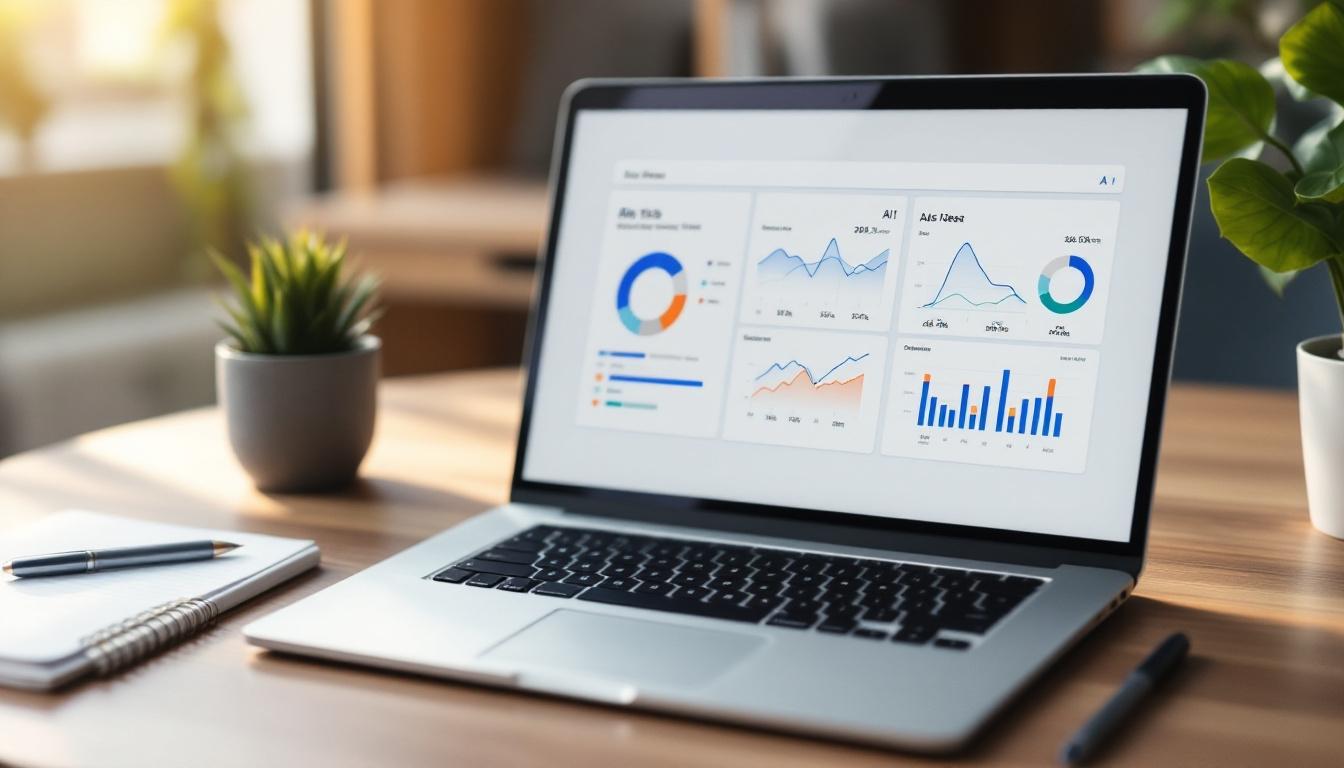At Help Reply, we’re excited about the potential of AI sales forecasting software to revolutionize business predictions. This cutting-edge technology is transforming how companies anticipate future sales and make strategic decisions.
AI-powered forecasting offers unparalleled accuracy and real-time insights, giving businesses a competitive edge in today’s fast-paced markets. In this post, we’ll explore how AI sales forecasting works, its benefits, and how you can implement it in your organization.
What Is AI Sales Forecasting?
Revolutionizing Sales Predictions
AI sales forecasting transforms how businesses predict future sales performance. It uses advanced machine learning algorithms to analyze extensive data sets, identify patterns, and generate accurate predictions. This approach differs significantly from traditional methods that primarily rely on historical data and human intuition.
The Power of Data-Driven Insights
AI forecasting systems process information from multiple sources (customer interactions, market trends, economic indicators). This comprehensive approach enables more nuanced and accurate predictions. AI forecasting engines can automate up to 50 percent of workforce-management tasks, leading to cost reductions of 10 to 15 percent while gradually improving performance.
Real-Time Adaptability
AI forecasting excels in its ability to adapt in real-time. While traditional methods often lag behind rapid market changes, AI systems quickly incorporate new data and adjust predictions. This flexibility proves essential in today’s dynamic business landscape.
Core Components of AI Forecasting Systems
AI sales forecasting systems typically include several key elements:
- Data Collection: AI gathers information from various sources (CRM systems, social media, economic databases).
- Data Processing: The system cleans and organizes collected data to ensure accuracy and relevance.
- Machine Learning Algorithms: These sophisticated tools analyze data and identify patterns to make predictions. Advanced techniques, such as neural networks, time series analysis, and statistical methods like moving averages, can enhance sales prediction using machine learning.
- Visualization Tools: AI presents forecasts in easy-to-understand formats for decision-makers.
- Feedback Loop: The system continuously learns from new data and outcomes to improve future predictions.
Integration with Existing Systems
AI sales forecasting doesn’t operate in isolation. It integrates seamlessly with existing business tools and processes. For instance, it can work alongside CRM systems, ERP platforms, and other data sources to provide a holistic view of sales performance and potential.

This integration allows for a more comprehensive analysis, taking into account factors that might be overlooked in traditional forecasting methods. As businesses continue to adopt AI-powered solutions across various operations, the potential for synergy between these systems grows exponentially.
How AI Boosts Sales Forecasting
Unparalleled Accuracy in Predictions
AI-driven logistics optimization can reduce costs through real-time forecasts and behavioral coaching. Application of AI techniques such as continuous analysis of vast amounts of data from multiple sources can identify complex patterns and trends that human analysts often miss.

This increased accuracy translates directly into better business decisions. A retail company using AI forecasting might more accurately predict seasonal demand fluctuations, allowing it to optimize inventory levels and reduce waste.
Real-Time Insights for Agile Decision Making
One of the most powerful aspects of AI sales forecasting is its ability to provide real-time insights. Unlike traditional methods that might update monthly or quarterly, AI systems continuously analyze incoming data and adjust predictions on the fly.
Data-driven forecasting enables you to make more informed decisions regarding your business by providing insights into the future. This real-time capability proves particularly valuable in fast-moving industries. A tech company launching a new product can use AI forecasting to monitor initial sales data and quickly adjust production or marketing strategies based on emerging trends.
Tailored Predictions for Diverse Markets
AI forecasting systems excel at providing personalized insights for different sales teams and markets. These systems generate tailored predictions for each market segment by analyzing specific regional data, customer demographics, and historical performance.
This level of customization allows companies to fine-tune their strategies for different regions or product lines. A global food and beverage company might use AI forecasting to predict demand for specific products in different countries, accounting for local tastes and cultural factors.
Efficiency Gains and Resource Optimization
Implementing AI sales forecasting leads to significant time and resource savings. These systems automate data collection and analysis, which frees up sales teams to focus on high-value activities like relationship building and closing deals.
Moreover, AI forecasting helps optimize resource allocation. With more accurate predictions, companies can better plan staffing needs, allocate marketing budgets, and manage inventory. This optimization results in substantial cost savings and improved operational efficiency.
AI-powered solutions transform business operations across various sectors. The principles of AI-driven efficiency and accuracy apply equally to sales forecasting, customer support, and other business functions. Companies that leverage AI technology gain a competitive edge, make more informed decisions, and drive growth in an increasingly complex market landscape.
As we move forward, it’s important to understand how businesses can effectively implement AI sales forecasting in their operations. The next section will explore the key steps and considerations for successfully integrating this powerful technology into existing business processes.
How to Implement AI Sales Forecasting
Select the Right AI Forecasting Tool
The first step in AI sales forecasting implementation is to choose the right tool for your business. Look for solutions that offer seamless integration with your existing CRM and data systems. AI in sales forecasting boosts accuracy, provides real-time insights, and enhances decision-making for business growth.

When you evaluate AI forecasting tools, consider factors such as scalability, customization options, and support level. Opt for solutions with a user-friendly interface and robust reporting features. The goal is to empower your sales team, not overwhelm them with complexity.
Prepare and Integrate Your Data
Data fuels AI sales forecasting. To ensure accurate predictions, prepare and integrate your data effectively. Start with an audit of your existing data sources and identify any gaps or inconsistencies.
Clean your data thoroughly by removing duplicates and correcting errors.
Integrate data from multiple sources, including your CRM, ERP systems, and external market data. The more comprehensive your data set, the more accurate your AI forecasts will be. Use data integration tools to streamline this process and ensure real-time data flow.
Train Your Sales Team
Successful implementation of AI sales forecasting requires buy-in from your sales team. Invest time to train your team on how to use the new system effectively.
Start with a comprehensive onboarding program that covers AI forecasting basics and benefits. Provide hands-on training sessions where team members practice using the tool with real data. Encourage questions and feedback to address concerns early on.
Create a culture of data-driven decision-making within your sales team. Show them how AI forecasts can help prioritize leads, optimize sales strategies, and ultimately close more deals.
Monitor and Improve Continuously
AI sales forecasting implementation is not a one-time event. It requires ongoing monitoring and refinement to ensure optimal performance. Review the accuracy of your forecasts regularly and compare them against actual results.
Use these insights to fine-tune your AI models and improve prediction accuracy over time.
Set up a feedback loop where sales team members report any discrepancies or unusual patterns they notice. This human oversight can help catch potential issues early and improve the overall reliability of your forecasts.
Consider partnering with AI experts or consultants to periodically review and optimize your forecasting system. Their specialized knowledge can help you stay at the forefront of AI technology and maximize the benefits for your business.
Final Thoughts
AI sales forecasting software has transformed business predictions. Companies now make accurate forecasts, adapt to market changes in real-time, and optimize sales strategies with precision. This technology empowers sales teams to make data-driven decisions that drive growth, increase productivity, and boost profitability.

The future of AI sales forecasting promises advanced algorithms, better system integration, and more intuitive insights. Businesses ready to embrace this technology should select the right tool, prepare their data meticulously, and train their sales team effectively. Continuous monitoring and refinement will maximize the system’s potential.
At Help Reply, we understand AI’s transformative power in business operations. Our focus on enhancing sales and customer support through rapid email responses aligns with the principles of AI-driven efficiency. Embrace AI technology to gain a competitive edge, make informed decisions, and drive growth in today’s complex market landscape.


Leave a Reply